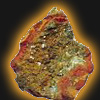
Adamite is a favorite among collectors of fluorescent minerals because of its consistent bright green fluorescence under short and long UV light. It also makes a wonderful mineral specimen in ordinary light. The typical lime green color of its adamantine (high luster) crystals set on top of its commonly associated red limonite matrix make specimens particularly attractive.
Adamite is isostructural with the minerals cuproadamite - (Cu, Zn)2(AsO4)(OH), olivenite - Cu2AsO4(OH) and libethenite - Cu2PO4(OH). This means that they share the same symmetry and similar crystal shapes. Cuproadamite, which is intermediate between adamite and olivenite, is not completely recognized as a different mineral from adamite but is becoming accepted in ordinary usage.
Endocrine system, glands, heart, lungs, throat.
Adamite is one of the amphibole group of minerals. Because its molecular structure is made up of long double chains of silicon atoms, adamite forms long, thin crystals, sometimes even fibers.

Sign of Adamite: Cancer
Element : Fire and Wind
Planet : Earth
Color : is typically green due to trace amounts copper and or uranium, yellow, rarely white and occasionally purple due to trace amount of cobalt.
A useful stone for uniting heart and mind together, Adamite provides clarity and inner strength when dealing with emotional issues. Helping you to move forward confidently into an unknown future, it brings to the fore entrepreneurial skills and the ability to identify new avenues for growth in both business and personal life. It is a stone that can take you back to first principles.
Notable occurrences include the famous mines at Mapimi, Mexico, also Greece and California and Utah, USA.
Adamite is not easy to mistake for any other mineral. Its bright green fluorescence, high luster, "sub" botyroidal crystal habit, high density, associations, typical bright green color and double triangle terminations make it both an exquisite specimen for a collection and an easy identification. Adamite typically shows a radiating habit that is intermediate between a simple druse and a botryoidal habit which gives a nice glimpse into how botryoidal habits form. The mineral forms a solid solution with the copper arsenate Olivenite and the structurally distinct member Zincolivenite. It is a secondary mineral found in zinc deposits containing arsenic-bearing minerals. Pure form of this mineral is colorless, but usually it possesses yellow color due to iron compounds.
